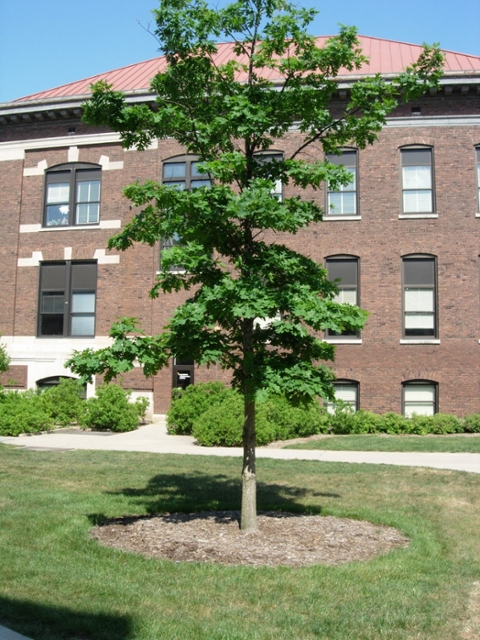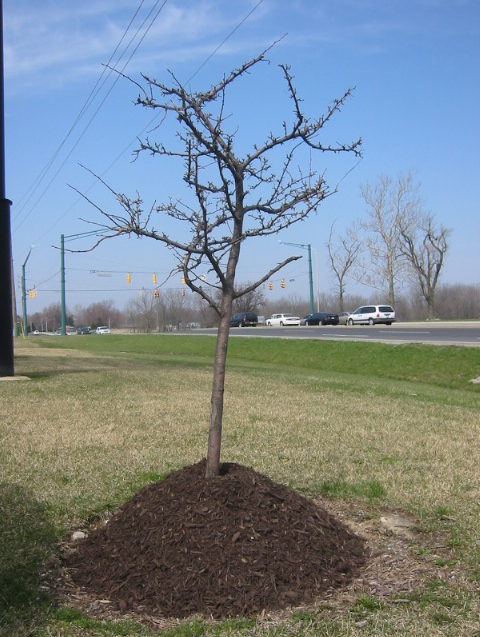Arbor Day is the last Friday in April in Indiana, a date strategically chosen to be right in the middle of one the best time periods all year to plant a tree in Indiana. Fall is also a good time. As you plant landscape trees and put the finishing touches of mulch around the tree, a Purdue expert cautions against overdoing the mulch.
Before rushing headlong into a tree purchase, it will pay to think about the location in which you hope to plant the tree. The reason for this is that you want the right tree in the right place.
Start with the site characteristics of the location in your landscape in which you want to plant a tree. Based on these characteristics, select a tree that is well-suited for the site. Things to consider include topography, drainage, soil type, whether it’s in full sun or partial shade, and proximity to power lines and structures. For example, in areas that collect and hold water (a low spot in your lawn), a river birch, swamp white oak or red maple would be well-suited, but most pines or spruces would probably struggle to thrive.
When planting your tree, avoid two of the most common mistakes people make: not accounting for the mature size of the tree, and an incorrect depth of the planting hole.
Saplings will eventually become mature trees in the landscape. You must account for the estimated mature size of the tree in height and in diameter of the crown. (The crown is a term for all the collective branches in the tree.) Don’t place a tree too close to structures or power lines.
The rule of thumb on planting depth is that the root flare, or fattened area of trunk just above the first main root, should be visible above the finished soil grade. Note that when purchasing balled-and-burlapped trees for planting, the top of the root ball may not be the location of the desired finished soil grade – the root flare may be farther down, requiring some excavation of soil on top of the root ball.
The final touch of tree planting is mulching the tree. The common mistake many homeowners (and even some commercial developments) make is mounding a “volcano” of mulch around the tree. Two to three inches of mulch should be added around the tree to help reduce water loss in the root zone, suppress weeds, and provide a visual cue to mowers to keep the mower deck away from the trunk, but no mulch should be in direct contact with the trunk. Leave a small air gap between the trunk and the beginning of the mulch ring.
Purdue Extension urban forestry specialist, Ben McCallister, recently offered some re-mulching advice for trees installed in prior years.
“Just like when they were placed in the ground, trees still benefit from mulch,” he said. “Reapplying mulch benefits trees in multiple ways. It’s a natural way to prevent weeds and grass competing in the root zone and adds a protective buffer against mechanical damage from mowers and weed eaters.” He added that it will also help to maintain moisture levels in the soil as we transition into the hotter summer months. “When applying new mulch, don’t worry about removing the old layer,” he said. “It’s working its way into the soil around the tree adding organic matter, improving the quality of the soil.”
“Add enough mulch so there is a 2–3-inch layer sloping away from the tree (Figure 1) with at least a 3–5-foot radius around the stem (older, larger trees can benefit from larger mulch rings),” he said. “No volcano mulching (Figure 2); make sure you also have around a 1-2-inch gap between the stem and the start of the mulch ring to prevent unwanted root growth above ground and rot from excess moisture on the stem.”
Find additional information from resources at Purdue Extension’s Education Store, www.edustore.purdue.edu. For tree planting tips, see Tree Installation: Process and Practices, FNR-433-W.

Figure 1: Correct application of mulch. Photo Credit John Bonkowski.

Figure 2: "Volcano mulching" around the base of the tree. Photo credit Lindsey Purcell.